Is there such a thing as flying ants? Yes, there are flying ants, known as alates, which are sexually mature queen and male ants that take to the skies for their nuptial flight, a crucial part of ant reproduction. This phenomenon is what Flyermedia.net is going to address, giving you the information on how the aerial mating ritual takes place. Discover insights into their behavior, lifecycle, and ecological significance, helping you understand why these winged insects are more fascinating than frightening and how Flyermedia.net keeps you updated with the latest news on aviation and wildlife interactions.
1. What Exactly Are Flying Ants?
Flying ants, scientifically referred to as alates, are indeed a real phenomenon. These are sexually mature female (queens) and male ants that possess wings, a feature that distinguishes them from the worker ants you typically see scurrying around. The primary purpose of these winged ants is reproduction.
Alates are essential for the survival and propagation of ant colonies. According to research from the Royal Society of Biology, these flying ants, particularly the black garden ant (Lasius niger), emerge in large numbers during specific times of the year to participate in what is known as the nuptial flight. This event is crucial for the mating and dispersal of ant species. The larger ants are the queens; they can be up to 15mm long.
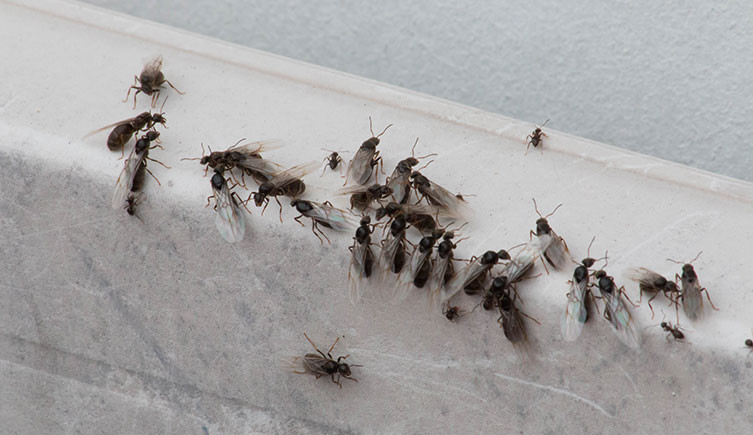 Black garden ant Lasius niger. The queens are much larger than the worker ants
Black garden ant Lasius niger. The queens are much larger than the worker ants
2. Why Do Ants Grow Wings and Fly?
Ants grow wings and fly as part of their reproductive process. This remarkable adaptation allows them to mate and establish new colonies.
2.1. Nuptial Flight: A Mating Ritual
The primary reason ants develop wings is to participate in the nuptial flight, a critical mating ritual. During this event, virgin queens and males take to the air to find mates from different colonies. This behavior ensures genetic diversity and prevents inbreeding, which is essential for the health and survival of ant populations.
2.2. Colony Expansion and New Beginnings
An ant colony has a limited capacity for expansion. When a colony reaches its maximum size, new queens must venture out to start their own colonies. Growing wings enables these queens to fly to new locations, meet males from other colonies, and establish new nests. This process is vital for the dispersal and colonization of new territories.
2.3. Avoiding Predation Through Swarming
Flying in large numbers, known as swarming, provides protection from predators. According to a study published in Ecological Entomology, the sheer number of flying ants overwhelms predators, increasing the chances of survival for individual ants. This strategy ensures that at least some ants will successfully mate and establish new colonies.
2.4. Maximizing Reproduction Chances
Swarming also increases the likelihood of successful reproduction. With a large number of ants in the air, the chances of finding a mate are significantly higher. The close proximity of potential mates ensures that the queens can quickly mate with several males, collecting enough sperm to fertilize eggs for the rest of their lives.
2.5. Genetic Diversity
By flying and mating with ants from different colonies, the alates contribute to the genetic diversity of the ant population. This genetic variation is crucial for the adaptation and survival of ant species in changing environments.
3. When Does Flying Ant Day Occur?
Flying ant day, or rather the flying ant season, typically occurs during the summer months, usually in July or August. However, the exact timing can vary depending on local weather conditions and geographic location.
3.1. Ideal Weather Conditions
The emergence of flying ants is closely tied to specific weather conditions. Warm and humid weather is ideal for their nuptial flights. According to research from the Royal Society of Biology, ants tend to fly on days when it is warm, not windy, and when conditions have improved compared to the previous day.
3.2. Urban vs. Rural Areas
Ants often fly earlier in urban areas compared to rural areas. This is primarily due to the urban heat island effect, where urban environments tend to be warmer than surrounding rural areas. The higher temperatures in cities trigger the emergence of flying ants sooner.
3.3. Misconception of a Single Day
Despite the term “flying ant day,” it’s important to note that the phenomenon doesn’t typically occur on a single day. Instead, there is a flying ant season that spans several weeks. During this time, there are often multiple peaks in appearances, each lasting only a few days. The exact pattern varies from year to year, making it challenging to predict the precise timing of swarming events.
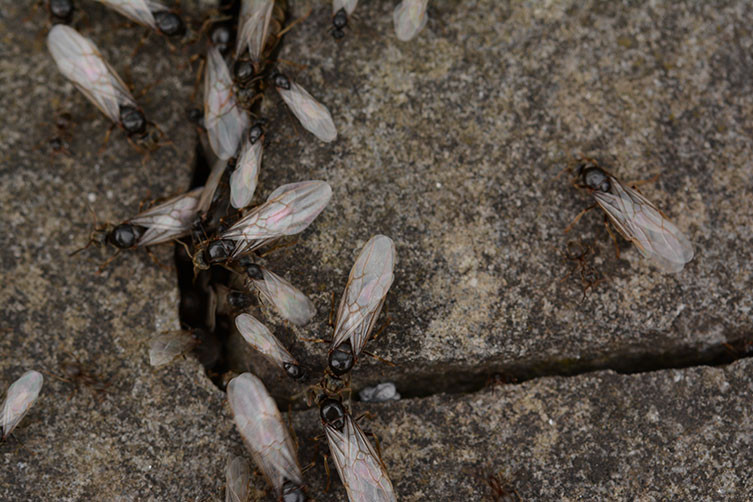 Winged ants about to fly
Winged ants about to fly
3.4. Citizen Science Project Findings
A multi-year citizen science project conducted by the Royal Society of Biology debunked the idea of a single flying ant day. The project found that winged ants emerge over several weeks, with peaks in appearances influenced by weather conditions. Swarming is triggered by warm, windless days following a period of improved weather.
3.5. Impact on Events
The emergence of flying ants can sometimes coincide with major events. For example, there have been instances where flying ants have disrupted tennis matches at Wimbledon, causing significant nuisance to players and spectators alike.
4. Where Do Flying Ants Come From?
Flying ants originate from established ant colonies. These colonies, often found in gardens, lawns, and under paving stones, are the breeding grounds for these winged insects.
4.1. Nesting Sites
Black garden ants typically nest in dry soil, making gardens, lawns, and patios their preferred nesting sites. They can also be found under paving slabs, stones, and in other dry, open areas warmed by the sun. These locations provide the ideal conditions for the development and growth of ant colonies.
4.2. Colony Structure
Ants live in a caste system where each individual has a specific role. The queen is responsible for laying eggs, while female workers care for the queen, eggs, and larvae. Workers also gather food, expand the nest, and ensure the colony runs smoothly. When the colony is ready, the queen begins to produce virgin queens and males, which eventually become the flying ants.
4.3. Preparation for Swarming
In the weeks leading up to the swarming event, you may notice heaps of soil appearing above the nests. This is a sign that the ants are preparing for the emergence of the winged alates. The winged males (drones) and virgin queens (princesses) emerge from the nest to maximize the chance of mating with individuals from different colonies, reducing the risk of inbreeding.
4.4. Dispersal Strategy
When the winged ants emerge, they scatter in different directions. This dispersal strategy ensures that mating occurs between different colonies, promoting genetic diversity. The alates are not interested in people or picnics; their sole focus is on finding a mate and establishing new colonies.
4.5. The Role of Workers
The worker ants play a crucial role in the development of flying ants. They provide the necessary resources and support for the queen to produce the winged alates. The workers also maintain the nest and protect the developing ants from predators and environmental threats.
5. What Happens After the Nuptial Flight?
After the nuptial flight, the lives of the male and female flying ants take very different paths. The males’ role is essentially over, while the newly mated queens embark on a journey to establish new colonies.
5.1. Fate of the Males
Once the males have mated with the queens, their purpose is fulfilled. They typically die within a day or two after the nuptial flight. Their existence is solely dedicated to mating and ensuring the continuation of their species.
5.2. Establishing New Colonies
Mated queens quickly chew off their own wings and begin searching for suitable nesting sites. This is why you often see large, wingless ants walking around after a flying ant day, and you may even find discarded wings scattered on pavements.
5.3. Creating an Underground Chamber
Once a queen finds a suitable location, she digs an underground chamber and lays her first few eggs. She rears these first larvae to adulthood, not eating for weeks until her first brood of daughter workers are ready to forage for food for her.
5.4. Lifelong Reproduction
The sperm the queen received during the nuptial flight enables her to lay fertilized eggs for the rest of her life. She can continue to reproduce for many years, often leading to colonies with thousands of workers. Large nests can contain more than 20,000 workers, all descended from a single queen.
5.5. The Role of Worker Ants
The ants you see throughout the rest of the year are female workers. These workers are responsible for gathering food, caring for the queen and larvae, and maintaining and expanding the nest. They play a vital role in the survival and growth of the colony.
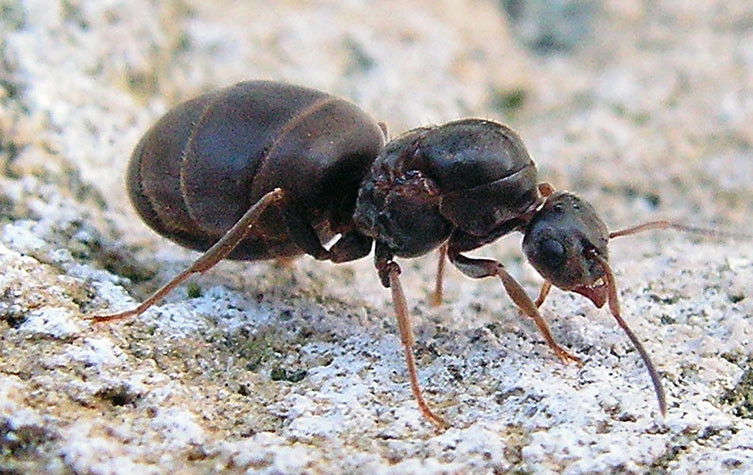 A queen ant that no longer has wings
A queen ant that no longer has wings
6. How Long Do Flying Ants Live?
The lifespan of flying ants varies significantly between males and queens. Understanding their respective lifespans provides insight into their roles within the ant colony.
6.1. Male Ants’ Short Lifespan
Male flying ants have a very short lifespan. They develop from unfertilized eggs and are produced by the colony only during the flying ant season. After the nuptial flight, male ants typically live for just another day or two, totaling about a week. Their sole purpose is to mate with new queens, and once that task is completed, they die.
6.2. Queen Ants’ Extended Lifespan
In contrast to the males, queen ants have a much longer lifespan. Lasius niger queens can generally live for up to 15 years. Some L. niger queens in captivity have even reached 28 years. These queens spend most of their lives in their nests, laying eggs and ensuring the continuation of their colonies. They only spend a small portion of their lives as winged or flying ants when they are young queens establishing new colonies.
6.3. Time as Winged Ants
Flying ants only spend a brief period as winged alates. For queens, this is when they leave their original nest, participate in the nuptial flight, and find a suitable location to start a new colony. After mating, they shed their wings and focus on laying eggs and building their colonies.
6.4. Environmental Factors
Environmental factors, such as temperature, humidity, and food availability, can also influence the lifespan of flying ants. Queens in well-established colonies with ample resources tend to live longer and produce more offspring.
6.5. Captive Studies
Studies conducted in captive environments have provided valuable insights into the potential lifespan of queen ants. These studies have shown that with proper care and optimal conditions, queen ants can live for extended periods, contributing to the long-term success of their colonies.
7. Why Are Flying Ants Actually a Good Thing?
Despite being seen as a nuisance by some, flying ants play several beneficial roles in the ecosystem. From improving soil quality to providing food for birds, their presence is more positive than many realize.
7.1. Improving Soil Quality
The tunnelling activities of ants contribute significantly to improving soil quality. As they dig and create nests, they aerate the soil, allowing for better water infiltration and nutrient distribution. This process helps to create a healthier environment for plant growth.
7.2. Providing a Food Resource for Birds
Flying ant swarms serve as a vital food resource for many bird species. Birds such as swifts and gulls can often be seen feeding frenziedly on the rising swarms of ants. This provides them with a substantial and easily accessible source of protein and energy, especially during the breeding season.
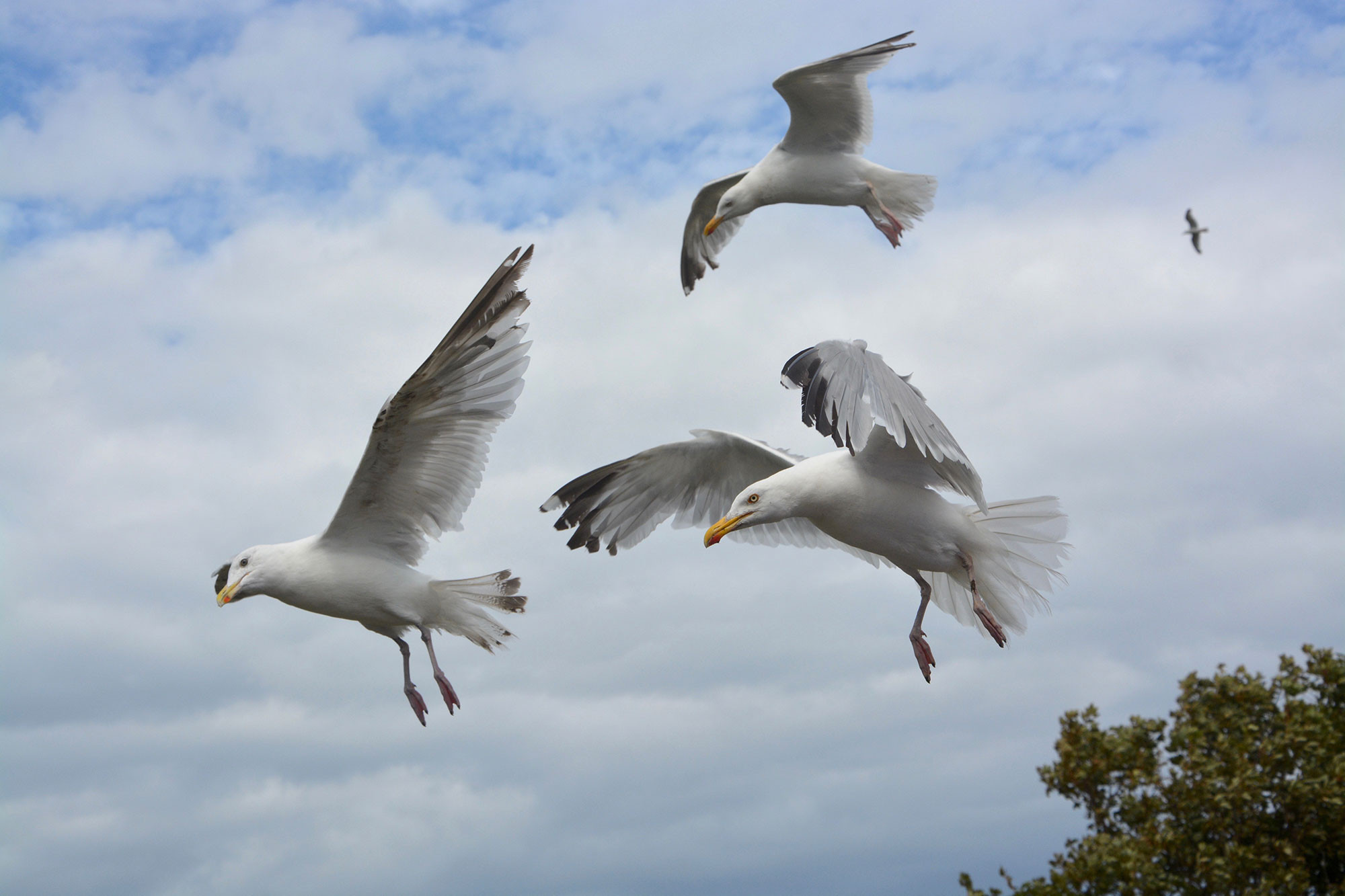 Three flying seagulls
Three flying seagulls
7.3. Supporting Butterfly Populations
Black garden ants and the related cornfield ant are particularly important to the survival of the silver-studded blue butterfly on heathland. The ants and the butterfly have developed a mutually beneficial relationship. The ants tend to the caterpillars, protecting them from predators, while in return, the ants feed on secretions produced by the caterpillars. This symbiotic relationship is crucial for the continued survival of both species.
7.4. Biodiversity
The presence of flying ants supports biodiversity by providing food for various predators and contributing to the health of ecosystems. Their activities influence soil structure, nutrient cycling, and plant growth, all of which are essential for maintaining a balanced and thriving environment.
7.5. Natural Pest Control
Ants also play a role in natural pest control. They prey on other insects and small invertebrates, helping to regulate populations and prevent outbreaks of harmful pests. This can be particularly beneficial in gardens and agricultural areas.
8. What Kinds of Ants Fly in the UK?
The UK is home to about 60 species of ants, and many of them participate in nuptial flights. However, the most commonly observed flying ant is the black garden ant.
8.1. Black Garden Ant (Lasius niger)
The black garden ant is the most prevalent species of flying ant in the UK, particularly in urban areas. These ants are easily recognizable by their dark color and relatively large size. They nest in gardens, lawns, and other dry, open areas.
8.2. Red Ants (Myrmica rubra)
Red ants, also known as Myrmica rubra, are another common species in Britain that grow wings and swarm. While they are less frequently observed than black garden ants during flying ant surveys, they are still a significant part of the UK’s ant population.
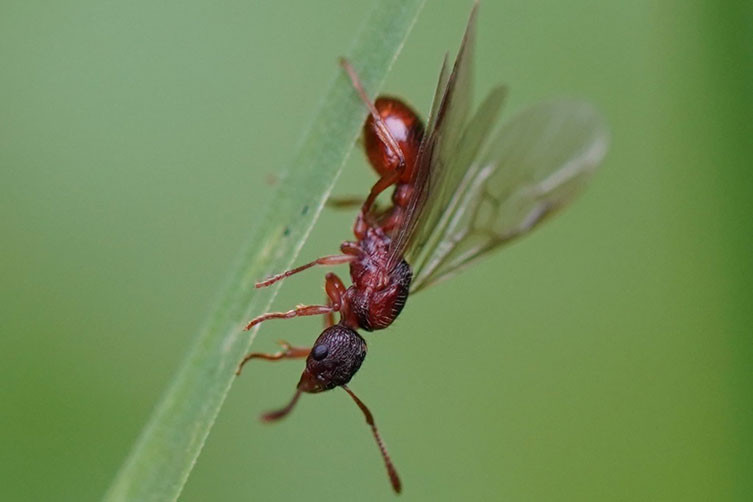 Winged Myrmica rubra ant
Winged Myrmica rubra ant
8.3. Wood Ants
In woodland areas, you may encounter wood ants that also participate in nuptial flights. These ants build large nests out of pine needles and other organic materials and play an important role in forest ecosystems.
8.4. Species Variation
The types of ants you see flying can vary depending on your location. Factors such as habitat, climate, and altitude influence the distribution of different ant species. Each species has its own preferred weather conditions for swarming, with temperature and humidity playing crucial roles.
8.5. Weather Conditions
All ants require good weather conditions to fly, with no rain or wind. The specific temperature and humidity levels that trigger swarming vary for each species. As a result, the timing of their nuptial flights will differ, contributing to the extended flying ant season in the UK.
9. How Can You Manage Flying Ants?
While flying ants are generally harmless and beneficial, their presence can be a nuisance. Here are some tips for managing them around your home:
9.1. Seal Entry Points
To prevent flying ants from entering your home, seal any cracks or openings in walls, windows, and doors. Use caulk or sealant to close gaps and ensure that your home is well-protected.
9.2. Keep Outdoor Areas Clean
Regularly clean outdoor areas such as patios and decks to remove food sources that may attract ants. Clear away fallen leaves, crumbs, and other debris to minimize their appeal.
9.3. Use Natural Repellents
Natural repellents like vinegar, lemon juice, and peppermint oil can deter ants from entering your home. Spray these substances around entry points and areas where you have seen ants.
9.4. Avoid Leaving Food Out
Store food in airtight containers and avoid leaving food out on counters or tables. Clean up spills immediately to prevent ants from being attracted to your home.
9.5. Professional Pest Control
If you have a severe infestation of flying ants, consider contacting a professional pest control service. They can provide effective treatments to eliminate ants and prevent them from returning.
10. What are Some Interesting Facts About Flying Ants?
Flying ants are fascinating creatures with unique behaviors and characteristics. Here are some interesting facts about them:
10.1. Nuptial Flight
The nuptial flight is a once-in-a-lifetime event for most flying ants. During this flight, queens mate with several males to collect enough sperm to fertilize eggs for the rest of their lives.
10.2. Wing Shedding
After mating, queen ants shed their wings. This is a crucial step as it signals their transition from a flying alate to a ground-dwelling queen focused on establishing a new colony.
10.3. Colony Size
Ant colonies can vary in size, ranging from a few dozen to thousands of individuals. Large colonies can have complex social structures and specialized roles for each member.
10.4. Queen Longevity
Queen ants can live for many years, with some species living for over a decade. Their longevity ensures the long-term survival and growth of their colonies.
10.5. Symbiotic Relationships
Ants often form symbiotic relationships with other species, such as aphids and butterflies. These relationships can be mutually beneficial, with each species providing resources or protection to the other.
10.6. Weather Sensitivity
Flying ants are highly sensitive to weather conditions. Warm and humid weather is ideal for their nuptial flights, while rain and wind can prevent them from flying.
10.7. Ecological Importance
Ants play a crucial role in ecosystems by aerating soil, dispersing seeds, and controlling pest populations. Their activities contribute to the health and balance of the environment.
Is there such a thing as flying ants? Absolutely, and they are a crucial part of our ecosystem. The world of flying ants is filled with intriguing behaviors and ecological significance. These winged insects play a vital role in soil health, biodiversity, and the food chain. To stay informed about the latest news in aviation, wildlife, and environmental interactions, visit Flyermedia.net. Flyermedia.net, your go-to source for all things aviation, offers comprehensive insights into flight training programs, aviation regulations, and career opportunities. Contact us today at Address: 600 S Clyde Morris Blvd, Daytona Beach, FL 32114, United States, Phone: +1 (386) 226-6000, or visit our Website: Flyermedia.net and let flyermedia.net help you take off into a world of aviation exploration!
FAQ About Flying Ants
- What are flying ants? Flying ants, or alates, are sexually mature queen and male ants that have wings and participate in nuptial flights for mating and establishing new colonies.
- Why do ants fly? Ants fly to mate with individuals from different colonies, ensuring genetic diversity and preventing inbreeding. This also allows queens to disperse and start new colonies.
- When do flying ants typically emerge? Flying ants usually emerge during the summer months, particularly in July and August, when the weather is warm and humid.
- Where do flying ants come from? Flying ants come from established ant colonies found in gardens, lawns, and under paving stones. The winged ants are produced when the colony is ready to expand.
- What happens after the nuptial flight? After mating, male ants die, while the mated queen chews off her wings and finds a suitable location to start a new colony, laying eggs and raising the first generation of workers.
- How long do flying ants live? Male flying ants live for only a day or two after the nuptial flight, while queen ants can live for many years, often over a decade, in their colonies.
- Are flying ants harmful? Flying ants are generally harmless to humans. They do not bite or sting and are more of a nuisance than a threat.
- Why do ants swarm in such large numbers? Swarming provides protection from predators and increases the chances of successful mating. The sheer number of ants overwhelms predators and ensures that at least some ants will survive to reproduce.
- What can I do to manage flying ants around my home? To manage flying ants, seal entry points, keep outdoor areas clean, use natural repellents, avoid leaving food out, and consider professional pest control if the infestation is severe.
- Do flying ants have any benefits? Yes, flying ants play a crucial role in ecosystems by improving soil quality, providing a food resource for birds, and supporting butterfly populations.